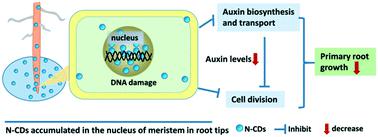当前位置:
X-MOL 学术
›
Environ. Sci.: Nano
›
论文详情
Our official English website, www.x-mol.net, welcomes your
feedback! (Note: you will need to create a separate account there.)
Response of primary root to nitrogen-doped carbon dots in Arabidopsis thaliana: alterations in auxin level and cell division activity
Environmental Science: Nano ( IF 5.8 ) Pub Date : 2021-3-26 , DOI: 10.1039/d1en00168j Xiaoyan Yan 1, 2, 3, 4, 5 , Jianhua Wang 1, 2, 3, 4, 5 , Dongxia Li 1, 2, 3, 4 , Jinlin Feng 1, 2, 3, 4, 5 , Qiang Xu 1, 2, 3, 4 , Huize Chen 1, 2, 3, 4, 5 , Rong Han 1, 2, 3, 4, 5
Environmental Science: Nano ( IF 5.8 ) Pub Date : 2021-3-26 , DOI: 10.1039/d1en00168j Xiaoyan Yan 1, 2, 3, 4, 5 , Jianhua Wang 1, 2, 3, 4, 5 , Dongxia Li 1, 2, 3, 4 , Jinlin Feng 1, 2, 3, 4, 5 , Qiang Xu 1, 2, 3, 4 , Huize Chen 1, 2, 3, 4, 5 , Rong Han 1, 2, 3, 4, 5
Affiliation

|
Fluorescent carbon dots have attracted wide attention in the fields of bioscience and bioimaging. However, to date, the molecular mechanisms of the effects of carbon dots on plant growth and development have not been elucidated. In this study, the roots of Arabidopsis thaliana seedlings were treated with nitrogen-doped carbon dots (N-CDs). After 6 h, N-CDs entered and accumulated in the cell nucleus of the meristem in the primary root (PR). The transcription of 6 auxin synthesis-related genes was significantly down-regulated in the toxic reaction of N-CDs. N-CD treatment also reduced the expression of the auxin efflux carriers PIN1 and PIN2, and then decreased the level of auxin in the root tip, resulting in the inhibition of PR growth. Moreover, N-CD stress induced a downregulation in the expression of cell cycle regulation genes and DNA damage repair genes in the PR of Arabidopsis thaliana seedlings, thus decelerating cell division in the root tips. Finally, we proposed the molecular mechanisms of N-CDs inhibiting the PR growth. This is not only conducive to evaluate the ecological environmental safety of N-CDs, but also provides a reference to further understand the molecular mechanism of the toxic effect of N-CDs on plants.
中文翻译:

拟南芥中初生根对氮掺杂碳点的响应:生长素水平和细胞分裂活性的变化
荧光碳点在生物科学和生物成像领域引起了广泛的关注。然而,迄今为止,碳点对植物生长和发育的分子机制尚未阐明。在这项研究中,拟南芥的根幼苗用氮掺杂碳点(N-CD)处理。6小时后,N-CDs进入并积累在主根(PR)的分生组织的细胞核中。N-CDs的毒性反应中6种生长素合成相关基因的转录被显着下调。N-CD处理还降低了生长素外排载体PIN1和PIN2的表达,然后降低了根尖中生长素的水平,从而抑制了PR的生长。此外,N-CD胁迫诱导拟南芥PR中细胞周期调控基因和DNA损伤修复基因的表达下调。幼苗,从而减缓根尖中的细胞分裂。最后,我们提出了N-CD抑制PR生长的分子机制。这不仅有利于评估N-CDs的生态环境安全性,而且为进一步了解N-CDs对植物的毒理作用的分子机理提供了参考。
更新日期:2021-04-12
中文翻译:

拟南芥中初生根对氮掺杂碳点的响应:生长素水平和细胞分裂活性的变化
荧光碳点在生物科学和生物成像领域引起了广泛的关注。然而,迄今为止,碳点对植物生长和发育的分子机制尚未阐明。在这项研究中,拟南芥的根幼苗用氮掺杂碳点(N-CD)处理。6小时后,N-CDs进入并积累在主根(PR)的分生组织的细胞核中。N-CDs的毒性反应中6种生长素合成相关基因的转录被显着下调。N-CD处理还降低了生长素外排载体PIN1和PIN2的表达,然后降低了根尖中生长素的水平,从而抑制了PR的生长。此外,N-CD胁迫诱导拟南芥PR中细胞周期调控基因和DNA损伤修复基因的表达下调。幼苗,从而减缓根尖中的细胞分裂。最后,我们提出了N-CD抑制PR生长的分子机制。这不仅有利于评估N-CDs的生态环境安全性,而且为进一步了解N-CDs对植物的毒理作用的分子机理提供了参考。









































 京公网安备 11010802027423号
京公网安备 11010802027423号